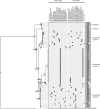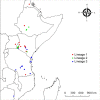Ongoing ecological speciation in Cotesia sesamiae, a biological control agent of cereal stem borers
- PMID: 26366198
- PMCID: PMC4561570
- DOI: 10.1111/eva.12260
Ongoing ecological speciation in Cotesia sesamiae, a biological control agent of cereal stem borers
Abstract
To develop efficient and safe biological control, we need to reliably identify natural enemy species, determine their host range, and understand the mechanisms that drive host range evolution. We investigated these points in Cotesia sesamiae, an African parasitic wasp of cereal stem borers. Phylogenetic analyses of 74 individual wasps, based on six mitochondrial and nuclear genes, revealed three lineages. We then investigated the ecological status (host plant and host insect ranges in the field, and host insect suitability tests) and the biological status (cross-mating tests) of the three lineages. We found that one highly supported lineage showed all the hallmarks of a cryptic species. It is associated with one host insect, Sesamia nonagrioides, and is reproductively isolated from the other two lineages by pre- and postmating barriers. The other two lineages had a more variable phylogenetic support, depending on the set of genes; they exhibited an overlapping and diversified range of host species and are not reproductively isolated from one another. We discuss the ecological conditions and mechanisms that likely generated this ongoing speciation and the relevance of this new specialist taxon in the genus Cotesia for biological control.
Keywords: Africa; Hymenoptera; adaptation; cryptic species; ecological niche; evolution; geographic distribution; host range; parasitic wasp; phylogeny; reproductive isolation; virulence.
Figures



Similar articles
-
The Cotesia sesamiae story: insight into host-range evolution in a Hymenoptera parasitoid and implication for its use in biological control programs.Genetica. 2017 Dec;145(6):455-468. doi: 10.1007/s10709-017-9989-3. Epub 2017 Sep 22. Genetica. 2017. PMID: 28939989 Review.
-
Systematics and biology of Cotesia typhae sp. n. (Hymenoptera, Braconidae, Microgastrinae), a potential biological control agent against the noctuid Mediterranean corn borer, Sesamia nonagrioides.Zookeys. 2017 Jul 5;(682):105-136. doi: 10.3897/zookeys.682.13016. eCollection 2017. Zookeys. 2017. PMID: 28769725 Free PMC article.
-
Phylogenetics and genetic diversity of the Cotesia flavipes complex of parasitoid wasps (Hymenoptera: Braconidae), biological control agents of lepidopteran stemborers.Mol Phylogenet Evol. 2012 Jun;63(3):904-14. doi: 10.1016/j.ympev.2012.03.003. Epub 2012 Mar 17. Mol Phylogenet Evol. 2012. PMID: 22450357
-
Intraspecific specialization of the generalist parasitoid Cotesia sesamiae revealed by polyDNAvirus polymorphism and associated with different Wolbachia infection.Mol Ecol. 2011 Mar;20(5):959-71. doi: 10.1111/j.1365-294X.2010.04977.x. Epub 2011 Jan 22. Mol Ecol. 2011. PMID: 21255170
-
Biology and management of economically important lepidopteran cereal stem borers in Africa.Annu Rev Entomol. 2002;47:701-31. doi: 10.1146/annurev.ento.47.091201.145254. Annu Rev Entomol. 2002. PMID: 11729089 Review.
Cited by
-
Reproductive Isolation in the Cryptic Species Complex of a Key Pest: Analysis of Mating and Rejection Behaviour of Onion Thrips (Thrips tabaci Lindeman).Biology (Basel). 2022 Mar 3;11(3):396. doi: 10.3390/biology11030396. Biology (Basel). 2022. PMID: 35336770 Free PMC article.
-
Global genetic diversity, lineage distribution, and Wolbachia infection of the alfalfa weevil Hypera postica (Coleoptera: Curculionidae).Ecol Evol. 2019 Aug 6;9(17):9546-9563. doi: 10.1002/ece3.5474. eCollection 2019 Sep. Ecol Evol. 2019. PMID: 31534674 Free PMC article.
-
The Cotesia sesamiae story: insight into host-range evolution in a Hymenoptera parasitoid and implication for its use in biological control programs.Genetica. 2017 Dec;145(6):455-468. doi: 10.1007/s10709-017-9989-3. Epub 2017 Sep 22. Genetica. 2017. PMID: 28939989 Review.
-
Genome-Wide Patterns of Bracovirus Chromosomal Integration into Multiple Host Tissues during Parasitism.J Virol. 2021 Oct 27;95(22):e0068421. doi: 10.1128/JVI.00684-21. Epub 2021 Jul 28. J Virol. 2021. PMID: 34319152 Free PMC article.
-
Patterns and Mechanisms of Niche Partitioning Between Related Parasitoids (Hymenoptera) Sharing the Same Host Species.Insects. 2025 Mar 25;16(4):340. doi: 10.3390/insects16040340. Insects. 2025. PMID: 40332803 Free PMC article. Review.
References
-
- Asgari S. Schmidt O. A coiled-coil region of an insect immune suppressor protein is involved in binding and uptake by haemocytes. Insect Biochemistry and Molecular Biology. 2002;32:497–504. - PubMed
-
- Baer CF, Tripp DW, Bjorksten TA. Antolin MF. Phylogeography of a parasitoid wasp (Diaeretiella rapae): no evidence of host-associated lineages. Molecular Ecology. 2004;13:1859–1869. - PubMed
-
- Barratt BIP, Oberprieler RG, Barton DM, Mouna M, Stevens M, Alonso-Zarazaga MA, Vink CJ, et al. Could research in the native range, and non-target host range in Australia, have helped predict host range of the parasitoid Microctonus aethiopoides Loan (Hymenoptera: Braconidae), a biological control agent introduced for Sitona discoideus Gyllenhal (Coleoptera: Curculionidae) in New Zealand? BioControl. 2012;57:751–758.
-
- Bézier A, Louis F, Jancek S, Periquet G, Thézé J, Gyapay G, Musset K, et al. Functional endogenous viral elements in the genome of the parasitoid wasp Cotesia congregata: insights into the evolutionary dynamics of bracoviruses. Philosophical Transactions of the Royal Society B. 2013;368:20130047. - PMC - PubMed
LinkOut - more resources
Full Text Sources
Other Literature Sources

